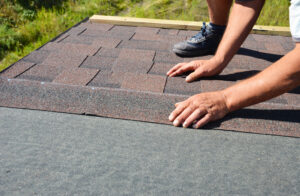The Ultimate Guide to Choosing Roofing Underlayment

*Updated April 29th, 2025
When people think about roofing, they usually picture shingles, tiles, or metal panels—but there’s a hidden hero that deserves way more attention: roofing underlayment. It might not be the most exciting part of the roof, but it plays a huge role in keeping your home protected from the elements.
Roofing underlayment is that extra layer of defense between your roof deck and the outside world. It helps keep water out, adds durability, and can even boost the lifespan of your entire roofing system. Without it, even the best shingles won’t stand a chance against heavy rain, snow, or strong winds.
Choosing the right underlayment is all about finding a material that’s tough, weather-resistant, and reliable year-round. Whether you’re building a new roof or replacing an old one, the right choice here can mean fewer headaches—and way fewer repair bills—down the line. In this guide, we’ll break down your options, explain what to look for, and help you find the best fit for your home and climate.
Types of Roofing Underlayment
When it comes to selecting the right underlayment for your roofing, there are several types to consider. The type of underlayment you choose can greatly affect the durability and effectiveness of your roof. Choosing the appropriate underlayment for your roofing depends on various factors, including your roof slope, the type of roof, and personal preferences. Here are the three main types of roofing underlayment:
1. Synthetic Underlayment
Synthetic underlayment is a modern option that has become popular due to its durability and lightweight. Made from materials such as polypropylene or polyester, synthetic underlayment offers superior waterproofing and resistance to tearing. It is also resistant to UV rays, which can help prolong the life of your roofing system.
2. Rubberized Asphalt Underlayment
Rubberized asphalt underlayment is an effective option for those with a shingle roof. This type of underlayment has self-sealing properties, which provide an extra layer of waterproofing and protection against moisture. It is made from asphalt and rubber polymers, making it an excellent choice for waterproofing and durability.
3. Traditional Felt Underlayment
Traditional felt underlayment, also known as roofing felt, is a more traditional option that has been used for many years. This type of underlayment is made from asphalt-saturated felt paper and is compatible with various roofing materials. While it is not as durable as synthetic or rubberized asphalt underlayments, it is still a reliable option for waterproofing and protection against moisture.
What is the Best Underlayment for Roofing?
The best underlayment for roofing depends on various factors such as the type of roof, slope, and personal preferences. Synthetic underlayment, rubberized asphalt underlayment, and traditional felt underlayment are all popular options with their own unique benefits. It’s important to consider your specific needs and consult with a professional to determine the best underlayment for your roofing project.
The Benefits of Synthetic Roof Underlayment
Synthetic underlayment has become increasingly popular for its durability and high-quality materials. It is made from a blend of asphalt and polymers, which creates a lightweight and tear-resistant material.
Synthetic underlayment has several benefits, making it a top choice for new roof installations:
- It’s lightweight and easy to handle, making it faster to install than traditional felt paper underlayments.
- It provides superior protection against water infiltration and is resistant to damage from wind and rain.
- It’s compatible with a range of roofing materials, including asphalt and metal roofing.
- It’s available in a variety of thicknesses, allowing you to choose the best underlayment for your roofing needs.
- It offers a long-lasting roof underlayment solution that can withstand extreme weather conditions.
The Advantages of Rubberized Asphalt Underlayment
When it comes to the best roof underlayment, rubberized underlayment stands out for its superior performance on asphalt shingle roofs. Rubberized asphalt underlayment is made with a combination of asphalt and rubber polymers, which results in a highly durable and long-lasting material.
The main advantage of rubberized asphalt underlayment is its ability to provide an excellent waterproof barrier that is also self-sealing. This type of underlayment is designed to withstand extreme weather conditions, making it a popular choice for properties in coastal areas, where storms and high winds are common.
The Benefits of Rubberized Asphalt Underlayment for Asphalt Shingle Roofs
If you have an asphalt shingle roof, rubberized asphalt underlayment is an ideal choice for several reasons. Firstly, it is easy to install and relatively lightweight, which means that it won’t add unnecessary weight to your roofing system.
Secondly, rubberized asphalt underlayment is also known for its exceptional resistance to tearing, which means that it can withstand heavy foot traffic during the roof installation process without suffering any damage.
Thirdly, this type of underlayment has excellent self-sealing properties that help to prevent water infiltration and ensure that your roof remains leak-free for many years to come.
Other Advantages of Rubberized Asphalt Underlayment
In addition to its benefits for asphalt shingle roofs, rubberized asphalt underlayment is also a great choice for other roofing systems. Some of the other advantages of this type of underlayment include:
- Resistance to high temperatures
- Long-lasting durability
- Easy to install
- Provides exceptional waterproofing
- Works well in conjunction with other roofing underlayments as well
Overall, rubberized asphalt underlayment is one of the best options for roof underlayments, particularly for asphalt shingle roofs. Its ability to provide a superior waterproof barrier and self-sealing properties makes it a top choice for residential and commercial properties alike.
Traditional Felt Underlayment Benefits
Traditional felt underlayment, also known as roofing felt, is a popular choice for residential roofing projects. It is made of organic or fiberglass materials and is designed to be installed between the roof deck and the roofing material.
One of the advantages of felt underlayment is that it is compatible with different types of roofing materials, including asphalt and metal roofing. It is also relatively easy to install and can be secured to the roof deck with roofing nails or staples.
There are three main types of traditional felt underlayment:
- Asphalt-saturated felt underlayment
- Fiberglass-reinforced felt underlayment
- Polymer-modified bitumen felt underlayment
Each type has its own unique characteristics and strengths. For example, asphalt-saturated felt underlayment is one of the most commonly used underlayment materials and has been around for many years. It is known for its affordability and effectiveness in protecting the roof deck from moisture.
On the other hand, fiberglass-reinforced felt underlayment is more durable and resistant to tearing, making it ideal for roofs with a steep slope. It is also suitable for use on roofs that are exposed to high winds and heavy rain.
Polymer-modified bitumen felt underlayment is a more advanced type of felt underlayment that is made with a blend of asphalt and rubber polymers. It is more expensive than other types of felt underlayments but is known for its superior performance and long-lasting durability.
Overall, traditional felt underlayment is a good option for residential roofing projects, as it provides a reliable layer of protection between the roof deck and roofing material. By choosing the right type of felt underlayment and using appropriate roofing nails or staples, you can ensure that your roof installation is secure and long-lasting.
Conclusion
Choosing the right underlayment is essential for a long-lasting roof. With so many different roofing options available, it can be a challenge to select the right underlayment for your project. However, by considering factors such as roof slope, roofing materials, and personal preferences, you can choose the best underlayment for your roofing needs.
One of the most critical functions of underlayment is to provide a waterproof barrier. Whether you opt for traditional asphalt-saturated felt underlayment or newer synthetic alternatives, your underlayment acts as an extra layer of protection between your roofing material and the roof deck.
When choosing the best underlayment for your roofing, you should also consider the different roofing materials available. For example, rubberized asphalt roofing underlayment is ideal for metal and asphalt roofing, while self-adhered roofing underlayment is perfect for shingle roofs.
The underlayment you select also depends on your budget. While some expensive types of underlayment may last longer than others, a traditional underlayment is also a good choice for long-lasting protection.
No matter which type of underlayment you use, it’s crucial to ensure that it is installed correctly. Underlayment is often used in combination with other roofing underlayments as well, such as tar paper or self-adhering underlayment.
Overall, your choice of underlayment depends on your roofing system and personal preferences. Synthetic underlayment is lighter and more durable than traditional underlayment, while rubberized asphalt underlayments are ideal for shingle roofs. By considering the factors discussed in this guide, you will be able to select the best underlayment for your roofing needs and enjoy a long-lasting roof for years to come.
FAQ
Why is roofing underlayment important?
Roofing underlayment is important because it acts as a barrier between your roof deck and the roofing material, providing an extra layer of defense against water infiltration. It helps protect your roof from elements like wind, rain, and snow, and enhances the overall durability and longevity of your roof. Investing in quality underlayment can help optimize your roof’s performance and protect your home from potential water damage.
What are the different types of roofing underlayment?
There are three main types of roofing underlayment: synthetic underlayment, rubberized asphalt underlayment, and traditional felt underlayment. Synthetic underlayment is known for its lightweight nature and resistance to tearing. Rubberized asphalt underlayment offers excellent protection against moisture and is especially suitable for asphalt shingle roofs. Traditional felt underlayment, also known as roofing felt, has been widely used in residential roofing projects for many years.
What are the benefits of synthetic roof underlayment?
Synthetic roof underlayment offers several benefits, including its lightweight nature, resistance to tearing, and ease of installation. It provides a reliable waterproof barrier and is compatible with various roofing materials. Synthetic underlayment is also known for its durability and can withstand harsh weather conditions, making it a popular choice for many homeowners.
What are the advantages of rubberized asphalt underlayment?
Rubberized asphalt underlayment offers excellent protection against moisture and is particularly suitable for asphalt shingle roofs. It has self-sealing properties that provide an additional layer of waterproofing, ensuring optimal roof protection. Rubberized asphalt underlayment is known for its durability and ability to withstand extreme weather conditions, making it a top choice for many roofing projects.
What is the role of traditional felt underlayment?
Traditional felt underlayment, also known as roofing felt, has been widely used in residential roofing projects for many years. It acts as a protective barrier between the roof deck and the roofing material, offering an extra layer of defense against water infiltration. Traditional felt underlayment is compatible with various roofing materials and plays a crucial role in protecting the roof deck from potential damage.
Additional Roofing Resources
- Choosing the Right Metal Roof Gauge
- Top Causes for Brown Spots on Your Ceiling
- Best Roofing Materials for Hot Climates
- The Ultimate Guide to Draining Water from a Flat Roof

Anna has over six years of experience in the home services and journalism industries and serves as the Content Manager at MyHomePros.com, specializing in making complex home improvement topics like HVAC, roofing, and plumbing accessible to all. With a bachelor’s degree in journalism from Auburn University, she excels in crafting localized, comprehensive guides that cater to homeowners’ unique needs. Living on both coasts of the United States has equipped her with a distinctive perspective, fueling her passion for turning any house into a cherished home through informed, personalized decision-making.








